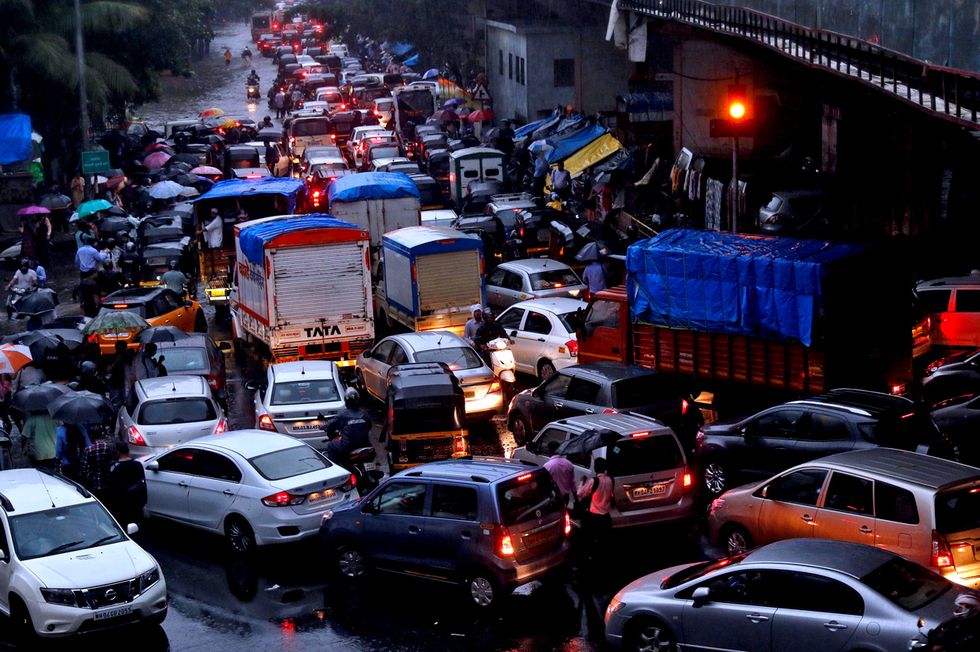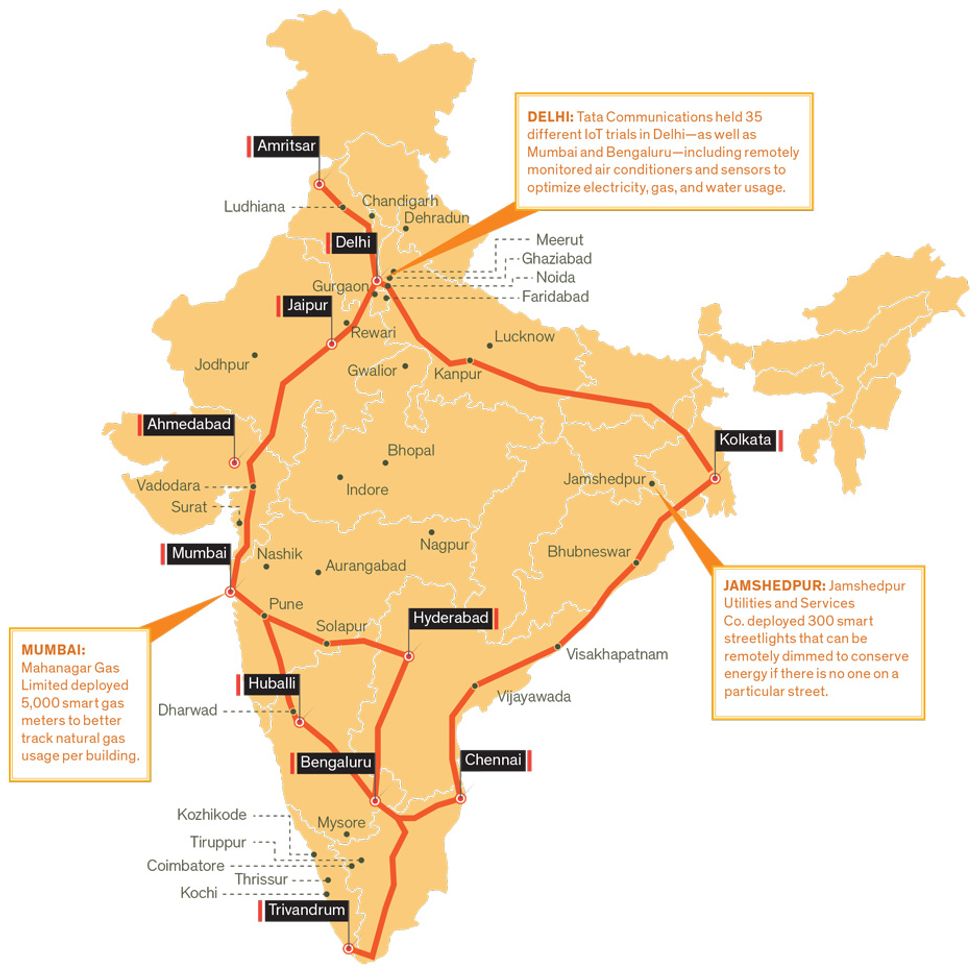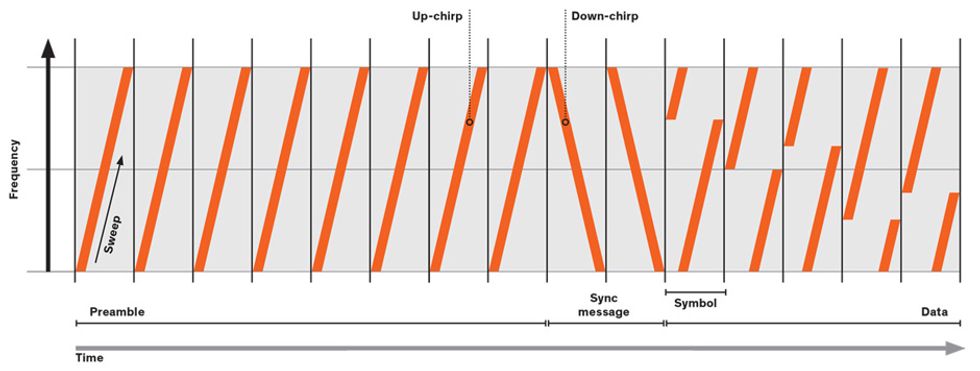Tata Communications’ Countrywide Internet of Things Will Manage the Chaos in India’s Booming Cities
The new network aims to improve traffic, manufacturing, health care, and more


The 20 million residents of Mumbai slog through monstrous traffic jams during monsoon season. The heavy rains that last from June until August frequently choke off the flow of traffic through India’s most populous city, leaving millions of Mumbaikars seething in their cars after a workday.
Though it’s particularly bad during monsoon season, Mumbai’s traffic is awful even on sunny days. And meanwhile, the number of vehicles in the city continues to grow. In 2012, there were just 2 million cars, scooters, and auto-rickshaws in Mumbai. Four years later, at the end of 2016 (the most recent year for which data is available), there were 3 million.
City planners are struggling to keep up. The city’s total road length—about 2,000 kilometers—has remained stagnant over the years. More vehicles, crowded onto the same length of road, means that there are now more than 1,500 vehicles per kilometer of road. That’s even worse than Los Angeles—infamous for its bad traffic—which, despite having far more cars (almost 6.5 million), has only about 600 vehicles per kilometer.
Mumbai has seen its population more than double since the early 1990s. The rapidly urbanizing city needs new ways to manage its traffic but also to cope with energy usage, waste management, and the other effects of escalating urbanization. For all of these problems, the Internet of Things (IoT) is a tool of great promise and potential power.
To be effective in such applications, the IoT would have to be deployed at a scale larger than any seen so far. And for that to happen, a country like India would first need a robust infrastructure backbone that could support such a vast rollout of machine-to-machine communications. That’s why Tata Communications (at which I am a senior vice president and head of the IoT division) has built a superlow-power, secure, bidirectional network specifically for massive IoT communications. It is now the world’s largest IoT network, connecting over 400 million people in India’s 44 largest cities as well as hundreds of villages along 12 national highways. Our goal was to offer a simple, energy-efficient way for any organization to provide large-scale IoT applications to ease the growing pains faced by India—and potentially by other developing countries as well.
Mumbai is one of many cities rushing to implement networks of connected devices and sensors to increase the efficiency of public services, reduce pollution, and improve quality of life in other ways, while also keeping costs under control. Local governments around the world are exploring smart-city systems as a way to address a variety of municipal crises. These projects are a cornerstone of efforts to create smart cities. There isn’t any universal agreement about what the term smart city means, though it now implies that a city is using IoT to make its municipal services more efficient by some metric. Analysts at the technology analysis firm IHS Markit project that there will be at least 88 smart cities globally by 2025—up from just 21 in 2013.

This fourfold boom in smart cities is one of the reasons the advisory company Gartner predicts that there will be more than 20 billion IoT nodes, or connected “things,” by 2020. You may not be able to feel their impact while you’re walking down the street today, but you will in some cities within a couple of years.
We’re already seeing how connected devices can improve services in more developed economies. For example, some cities in Europe now have connected garbage trucks and garbage bins. Using IoT-enabled sensors, the bins can tell sanitation workers when they are full or nearly so, so that they can be collected. This approach is more energy efficient and cost effective than sticking to a set schedule, because trash accumulation varies widely: It’s heaviest during holiday periods such as Christmas, and lowest when many households are away on vacation, for example during the summer. Such a flexible schedule also helps to ease the flow of waste into landfill and recycling facilities, and to improve air quality by reducing pollution. City planners in many developed regions are also exploring how systems of IoT nodes can enable more interactive and responsive city administration, create safer public spaces, and meet the needs of aging populations.
In developing countries, smart devices have the potential to truly transform people’s quality of life by completely changing the way in which services are delivered. For India especially, the Make in India program—the government’s recent plan to turn the country into a leading global manufacturing hub—is just the sort of ambitious project that can benefit from large-scale IoT networks.
Launched in 2014, Make in India has prioritized upgrading infrastructure, supporting innovation, and developing skills in the country across 25 sectors of the economy, including railways, mining, and pharmaceuticals. The program has been criticized by some industry leaders who feel it has failed to develop the policies and skilled workers needed to achieve significant results. Nevertheless, it has attracted investment into India from such large electronic systems manufacturers as Huawei, Lenovo, and Samsung.
If this effort succeeds, industrial facilities could become smarter and better connected than ever, accruing substantial savings and even environmental benefits. For example, with data from sensors directly connected to a building’s control system, management could adjust light and heating levels based on how many people are in the building.
There’s even good news for individuals. Remember those beleaguered drivers on the congested streets of Mumbai? Think about the collective time that millions of Mumbaikars could save if traffic lights could adjust to conditions on the road ahead and redirect vehicles before traffic ever had the opportunity to explode into rush hour chaos. In addition, with data collected from IoT sensors connected to a citywide traffic-management system, gridlocked Mumbaikars could use more-accurate route-mapping apps, get real-time notifications of parking spaces available, and even check predictive analytics to see which parking spots will most likely be available when they arrive at their destinations. The days of driving around the block endlessly to find a spot or risking a ticket for double parking will be long gone.
India’s IoT Network
This bright urban future won’t happen unless we can overcome a significant barrier: Different IoT devices and applications rely on different standards and technologies. Because of this incompatibility, engineers must often coax devices to work together in order to connect people, smartphones, and sensors.
This was one of the key challenges we at Tata Communications wanted to address four years ago as we started to build our IoT-focused network in India. By building our new network from the ground up, we could be sure that our engineers wouldn’t get headaches trying to make devices communicate with one another later on. The end result is a uniform IoT-focused network that cities or companies can easily tap into for their own projects.
For example, in one use of the network, we deployed 300 smart streetlights in the city of Jamshedpur for Jamshedpur Utilities and Services Co. (JUSCO). We hope the project can reduce electricity consumption by switching the lights on and off or dimming them remotely from a central command center based on the amount of traffic on any given street. If the system works in Jamshedpur, we plan to install thousands more of these streetlights in cities across India.
In Mumbai, we partnered with Mahanagar Gas Limited (MGL) to deploy 5,000 smart gas meters in the city. MGL can monitor these meters to analyze each building’s gas usage in finer detail, which will allow the company to deliver natural gas more effectively.
Building a single network for a country as expansive as India without breaking the bank or sucking too much power is a major challenge. To make it possible, we’re using long-range low-power (LoRa) wireless communications in the 865-to-867-megahertz range. LoRa is a communication technology patented by wireless semiconductor manufacturer Cycleo (now owned by semiconductor supplier Semtech). It doesn’t require the ravenous power consumption of wireless options that would otherwise make large-scale networks challenging.
LoRa keeps power consumption low by using a signal’s chirp—its change in frequency—to send information. Chirps come in two varieties: up-chirps, in which the signal’s frequency increases, and down-chirps, in which it decreases. LoRa modulates these up-chirps and down-chirps to encode data. This technique uses less power at the cost of requiring a wider frequency band for communication. The power usage is so low that the battery in an IoT device connected to our network could last for more than a decade without replacement.
This chirp modulation is an example of a technique called spread spectrum. Spread-spectrum methods take advantage of a larger bandwidth than other types of signals, whether by a transmitter shifting the signal to different frequencies or deliberately filling other frequencies in the band with interference. Regardless of the method, the goal of any spread-spectrum technique is to prevent interference from other signals or provide more secure communications. LoRa’s resistance to interference works by “sweeping” the signal across a 125-, 250-, or 500-kilohertz-wide band assigned to the network.
Any LoRa signal starts with eight up-chirps—in which the signal sweeps across the entire band each time—to give a receiver a heads-up that it needs to start listening for a message, as shown in the illustration above. This alert is critical, as all the IoT devices in a network are using that same frequency band. Without the use of a “preamble” to grab a receiver’s attention, the subsequent message could easily be missed. Two down-chirps follow, to sync the receiver as it receives the message.
The message itself is composed of symbols. Each symbol represents a predetermined string of bits and corresponds to the point in the band where the chirp begins. As the signal moves to the next symbol in the message, it jumps to a new frequency and completes a sweep across the band, ending at the same frequency where it began. Each subsequent symbol denotes another jump in the frequency before the next sweep. To decode the message, the receiver just needs to note the point in the band where each chirp started and match it to the corresponding symbol.
The network has impressive reach because an antenna receiving information is listening only for the frequency at which the next chirp starts. That’s much easier for an antenna to hear than information that has been encoded through other methods, like frequency or amplitude modulation. Signals can easily travel more than 15 kilometers and can penetrate a concrete wall—or three plaster walls. Such penetration means the system can be used to monitor trains coming and going in metro stations, the number of cars in an underground parking lot, the water level in a reservoir—all sites that are difficult or impossible for traditional wireless systems. Compared with traditional wireless technologies—such as Bluetooth, LTE, Wi-Fi, or ZigBee—LoRa allows networks to reach farther, with less power and cost.
Even with the capabilities of LoRa, building a network that can function well across India’s vast geographical disparity and for its huge population was still a significant challenge. The trickiest part is that the frequencies from 865 to 867 MHz are unlicensed spectrum in India. So, when designing the network, we had to consider that others might be using the same band at the same time for other applications. Because LoRa signals sweep across an entire band, they are somewhat impervious to interference caused by other signals transmitting on a specific frequency in that band. Even so, enough other traffic on the same frequencies could still interfere with LoRa signals and prevent them from reaching their destination.
In 2018, the network’s first command center opened in the city of Jamshedpur. In this center, JUSCO is using over 100,000 sensors to digitize 15 elements of its infrastructure, including streetlights, utilities, and parking meters, all connected to India’s first IoT network. The command center will allow JUSCO to reduce the city’s energy use, increase waste-management efficiency, make construction sites safer, and alleviate rush-hour traffic.
While this IoT network will connect more people than ever before, there are other, similar projects in the country planned to help make cities and communities better connected: Kochi in the state of Kerala, Coimbatore in Tamil Nadu, and Bhubaneswar in Odisha have ambitions to become smart cities, and there is a smart-city project already under way near Ahmedabad, in the western state of Gujarat, called Gujarat International Finance Tec-City (GIFT).
Its developers hope GIFT becomes not only the country’s first full-fledged smart city but also a rival for Hong Kong, London, New York City, and Singapore as a major global financial services center. The Bombay Stock Exchange has already set up an international exchange in GIFT, and the data-center and connectivity infrastructure to underpin the smart systems of the city is being deployed now.
But the most promising development is that India’s smart ambitions aren’t confined to cities. The state of Rajasthan, for example, has plans to develop more than 3,000 smart villages with connected utility systems to provide access to clean drinking water, widespread Wi-Fi connectivity, e-libraries, smart streetlights, and telehealth facilities.
From Mumbai and Jamshedpur in India to the rest of Asia and beyond, smart cities are being built using large-scale IoT networks. These always-connected communities will transform the lives of hundreds of millions of people. We are just at the beginning of this journey, but nowhere will the positive outcomes be greater than in the cities of India.
This article appears in the February 2019 print issue as “The India of Things.”
About the Author
V.S. Shridhar is senior vice president and head of the Internet of Things division at Tata Communications, in Chennai.

